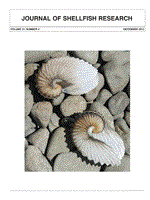Cryopreservation can preserve genetic materials in perpetuity and can be applied to oyster culture for breeding programs. Protocols exist for sperm cryopreservation in the eastern oyster Crassostrea virginica, but nonlethal sample collection is needed for valuable individuals, such as tetraploids, or specific lines. The goal of this study was to develop nonlethal methods for sperm collection in the eastern oyster. The objectives were (1) to evaluate natural spawning as a collection method, (2) to evaluate anesthesia methods to induce shell opening for biopsy, (3) to evaluate mechanical notching for biopsy, and (4) to verify notching combined with biopsy for collection and cryopreservation. Five males (of 60 oysters) spawned naturally after 7 h, with an average sperm concentration of 1.9 ± 1.0 × 103 cells/mL (in 2 L seawater). No oysters (n = 30) responded by opening during 36 h of treatment with 5% Dead Sea salt (containing 33.3% MgCl2), and 22 oysters (of 30) opened during the 36-h treatment with 5% Epson salt (MgSO4). Sperm collected by biopsy had fresh motility of 3%–80% and postthaw motility of 1%–5%; sperm production was 4.5 × 105 to 2.3 × 108 cells per male. Mechanical notching did not cause mortality to oysters (n = 20). After notching and biopsy with 18-G and 20-G needles, survival was 80% (16 of 20 for each). Sperm production was 5.42 × 107 cells by 18-G needle (n = 8) with fresh motility of 16 ± 12% and postthaw motility of 3 ± 2%, and 1.35 × 108 cells by 20-G needle (n = 9) with fresh motility of 21 ± 20% and postthaw motility of 5 ± 4%. No differences were observed between samples biopsied with the 2 needle sizes (P ≥ 0.074). To verify notching and biopsy for nonlethal sperm collection, a total of 39 oysters were sampled to obtain 20 males, which averaged 99.48 ± 23.17 g total weight, 74.1 ± 6.0 mm shell height, and 60.9 ± 7.2 mm shell length. The sperm production was 3.6 ± 2.1 × 108 cells per male. Biopsied sperm showed 23 ± 12% fresh motility, 13 ± 6% postequilibration motility (after equilibration with 10% of DMSO for 30–60 min before freezing), and 6 ± 4% postthaw motility. Flow cytometry analysis indicated an average of 84 ± 4% of cells with intact plasma membranes for fresh sperm, and 59 ± 9% for postthaw sperm. Fertilization by thawed sperm averaged 20 ± 22% (from 1%–87%). No significant differences were observed between the biopsied samples and the dissected samples (lethal collection) for fresh motility (P = 0.550), postequilibration motility (P = 1.000), postthaw motility (P = 0.101), fresh membrane integrity (P = 1.000), or postthaw membrane integrity (P = 1.000), but a difference was observed in fertilization (P = 0.039; biopsied samples, 20 ± 22%; dissected samples, 68 ± 40%). Overall, this study developed notching combined with biopsy for sperm collection and cryopreservation in Eastern oysters that can be applied to valuable individuals and breeding programs.
How to translate text using browser tools
1 August 2013
Nonlethal Sperm Colleclion and Cryopreservation in the Eastern Oyster Crassostrea virginica
Huiping Yang,
John Supan,
Ximing Guo,
Terrence R. Tiersch
ACCESS THE FULL ARTICLE

Journal of Shellfish Research
Vol. 32 • No. 2
August 2013
Vol. 32 • No. 2
August 2013
Crassostrea virginica
eastern oyster
nonlethal collection
sperm cryopreservation




